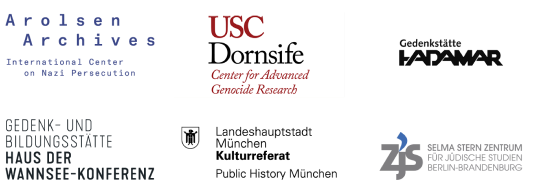Annotations
Breslau
04/13/1942
Women carrying backpacks tied with blankets stand at theentrance of the “Schießwerder” restaurant and event venue. You can see the restaurant’s sign, advertising boards, a bicycle leaning against the wall and a fire alarm to the right.
Annotations
Keywords
5
Historical context
Deportation von Breslau nach Izbica am 13.04.1942
On April 13, 1942, the second deportation of Jews from Breslau took place, the destination of which was the Izbica transit ghetto in the Lublin district. As of April 9 already, approximately 1.000 people were taken to the “Schießwerder” restaurant and event venue and to the so-called “Freundesaal” (friends’ hall) on Graupenstraße. There they spent three days in inhumane conditions before they were taken to the Breslau Odertor station. The locked passenger train arrived at Izbica after a three-day journey. During a stop, the young men were selected directly from the train for work in the Majdanek concentration camp. The Izbica transit ghetto was completely overcrowded with 18,000 people, life conditions were disastrous and the death toll was high. Initially, relatives in Breslau received postcards from the deportees asking for food and money. In the fall, the Breslau and other Jews were murdered in the gas chambers in Sobibór and Bełżec . Only two persons are known to have survived.
About the image series
The series consists of the original print of a photo probably taken by Albert Hadda between April 9 and April 13, 1942. He photographically documented the arrival of the persecutees at the “Schießwerder” assembly camp, a big restaurant near Odertor train station in Breslau.
The picture shows four persons carrying the heavy typical deportation luggage. Judging from their clothes, they were elderly women, but they can only be seen from behind. In the entrance area of the restaurant, another person can be discerned. Next to the entrance area, you can see a parked bicycle and a car. Trees recognizably having leaves are reflected in the entrance door.
Photographer
Albert Hadda, Architekt
Albert Hadda, born in Cosel in 1892, grew up with four siblings in a religious home. He studied architecture in Breslauunder Hans Poelzig. He worked for Walter Gropius in Berlin later. After being banned from their professions in 1934, he and his brothers Moritz (architect) and Siegmund (physician) worked for the Jewish community. Their sister Else and brother Willy emigrated. As a Zionist, Hadda gave courses for migration. He was a skillful photographer and kept his camera – despite the ban. Time and again, he took secret photos Being married to a Christian, he escaped deportation. Moritz was deported to Kaunas in 1941, Siegmund to Theresienstadt in 1943. In 1944, Albert was sent to the Grüntal labor camp, but fled to Breslau. He survived and migrated to Israel joining his daughters there.
Provenance
Together with twelve other photos documenting the deportation in November 1941, the picture has been preserved in the archives of Saxony’s land association of the Jewish communities in Dresden. The original prints were kept in an envelope labeled “Miscellaneous”. It is most probable that the thirteen photos found their way to Erfurt with a group of survivors from Breslau, among them Albert Hadda, in late summer 1945. How they came to Dresden has not finally been clarified. Either Werner Sander handed them in, or they were taken to Dresden as a result of the move of the association of Jewish communities in the GDR to the city in 1962. After 1950, the Ghetto Fighters’ House Memorial in Israel received seven negatives probably photographed by the historian Helmut Eschwege.
Call number at source archive
Ohne Signatur
Title at source archive
Ohne Titel
Acknowledgements
We thank Steffen Heidrich, who has discovered the pictures in the archives of Saxony’s land association of the Jewish communities in Dresden, and the land association for sharing the images. We would also like to thank Katharina Friedla, Maria Luft, Daniel Ljunggren, and Tim Buchen for their valuable advice.
Text and research by Ramona Bräu-Herget.
Kooperationsverbund #LastSeen. Bilder der NS-Deportationen Dr. Alina Bothe Projektleiterin
c/o Selma Stern Zentrum für Jüdische Studien Berlin-Brandenburg
Freie Universität Berlin
Habelschwerdter Allee 34A
14195 Berlin
lastseen@zedat.fu-berlin.de
Ein Kooperationsprojekt von

Gefördert durch

Datenschutz | Impressum